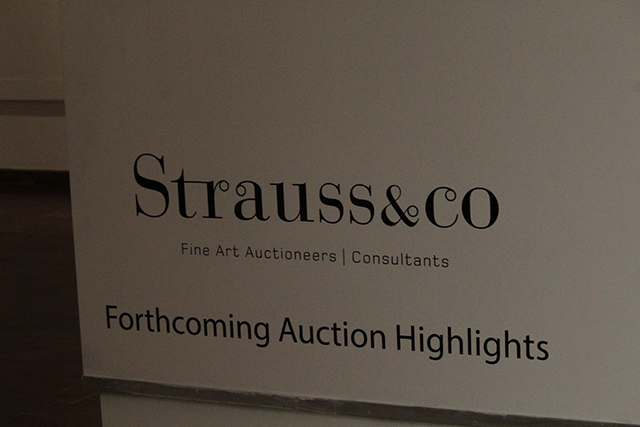Writing: Reviews & Think Pieces
Art auction houses: the National Arts Festival’s sore thumb!
I had just met Annali Dempsey, the University of Johannesburg’s (UJ) Art Gallery curator and Niel Nortje, curator of the MTN Collection. The two had had been orientating me for the Shifting Conversations exhibition walkabouts that I had to do throughout the duration of the National Arts Festival. The venue was the Albany History Museum, and to get to the space where the exhibition was, I passed through the main gallery where Lionel Davis’ Gathering Strands was housed.
As I came out, I was shocked to discover that Strauss & Co occupied the room adjacent to Davies’ exhibition. It just did not go down well with me, and their presence made me uncomfortable, as I had not expected to find them in the museum. I debated the issue with a colleague operating their space. He did not have a problem with them being part of the National Arts Festival, much less in their occupation of space. After all, they had created temporary employment for him. When I visited the Rhodes University Fine Arts Department, I also found Aspire Art Auction in the building, their door directly opposite the room on which Heidi Sincuba’s Exploitation! was exhibited. When I raised the issue with a friend who is a curator, she simply told me the best I could do was to ignore their presence, “They do not deserve any publicity”, she concluded. I could not stop wondering if it was appropriate to have these auction houses in the prime spaces they occupied.
My problem with art auction houses is their manner of doing business, which I find too discreet. Dealing with them means bypassing all the work and activities associated with ordinary art galleries in the primary market. In the context of the normal world of art, they deprive the public of an opportunity to view well-curated shows in galleries. I have seen a few collaborations between galleries and auction houses, and it is a relationship I am still skeptical about. International audiences have become a priority for auction houses chasing after profits. According to Mail & Guardian (20/03/2015), Bonhams, for example, now hosts three South African art auctions in London every year. There is also a shift towards the promotion of online deals that are highly susceptible to forgery, as was the case with the work of Frans Claerhout in Bloemfontein. Recently, sections of the Nigerian art community were arguing over whether or not art auction houses promote the theft of art, in the wake of Tola Wewe’s Iye Baobo and Ben Enwonu’s Tutu; both works had been stolen for years, only to resurface at auctions. South African art is not immune from theft as well. That the onus of proving the authenticity of a work is on the buyer as per the terms and conditions of most auction houses is a problematic symptom of the perpetuation and normalization of such fraudulent art dealings.
Art is not only supposed to be for perusal by the elite and perhaps the old rich couples often seen frequenting the two auction houses’ spaces during the festival. It is for both the young and the old, the rich and the poor. It is for everyone and should be an inclusive activity. Even the penniless student can get inspiration from viewing the work of others in an art gallery. Such opportunities are rarely accorded by auction houses.
As much as they are not innocent of exploitation and easy access, galleries do nurture artists in many ways. They are spaces where artists meet and talk to each other, and provide platforms to network and share ideas. They organize walkabouts, public talks and panel discussions with artists, curators and critics. A word of encouragement or feedback from the art community to an artist can go a long way in motivating and developing an artist’s career in the end. In most cases, even collectors get to meet artists in such spaces because as part of their function galleries cultivate a buyer base for their artists. Unlike the secrecy surrounding the deals happening in auctions or the secondary market, long-lasting relationships between artists and collectors are usually established in and through galleries. Moreover, they do protect the nation’s heritage through their permanent collections.
With the auction houses invading the turf of galleries outside the festival, chances are that the public will not have access to some fine artworks and that will just circulate in private hands. Works will pass from one buyer to the other within elite collector circles. Displaying these works for public viewing in gallery spaces will actually depend on the goodwill of such collectors. Otherwise, they will just keep them in storage until the time they feel they need to sell them to the next highest bidder. Art auction houses pose a threat to the culture of public art gallery shows.
When Melissa Goba and Johan Myburg curated Shifting Conversations, they initiated the public into dialogues and debates around artworks seen as problematic within the exhibition and beyond. Others might argue in favor of art auction houses, as they are the hallmark of a well-established secondary market in Western Europe and the United States. I, however, think it appropriate to shift the conversation to include the role of art auction houses and their presence in public art fairs and festivals in the relatively smaller art markets like that of South Africa, and in making art inaccessible to ordinary people. Is South Africa and Africa for that matter, ready yet for such art auctions or not?

Strauss & Co at the Albany History Museum in the just ended National Arts Festival
Barnabas Ticha Muvhuti is a PhD candidate with the NRF/DST SARChI Chair Geopolitics and the Arts of Africa, Arts of Africa and Global Souths research programme headed by Prof Ruth Simbao at the Department of Fine Arts, Rhodes University, South Africa.
Last Modified: Mon, 11 Feb 2019 10:34:26 SAST
